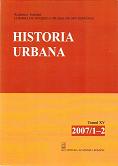Funcţionarul BNR în perioada interbelică, între rigoarea profesională şi realitatea socială urbană
The NBR Official in the Inter- World Wars Period, between the Professional Rigour and the Urban Social Reality
Author(s): Brînduşa Costache, Nadia ManeaSubject(s): History
Published by: Editura Academiei Române
Keywords: National Bank of Romania; bank employees; social prestige; urban social realities; salaries; working program; everyday life;
Summary/Abstract: After the First World War, the National Bank of Romania celebrated four decades since its foundation, and the dignity of its officials, both of those working in the central administration and of the employees from the branches and agencies, had become a characteristic of the social and professional image of the time. The documents from the NBR’s archives, recently accepted as scientific evidence, offer information which allows not only the establishment of those elements that represented the origin of this perception, but also the creation of a complex picture of an average clerk’s existence, the one who worked with the customers at the bank’s front desks or in the institution’s offices, totally agreeing or disagreeing with a certain level of exigency and the moral of that epoch. This clerk did not belong either to the category of the bank’s high officials (governors, managers, executives and censors) or to “the other personnel”, made of guardians, doormen, janitors etc. Still, this clerk, to whom we will give the opportunity, in the following lines, to express himself, covers a large area of employees, starting with the daily-paid and temporary employee until the executive or the manager of a branch or agency of NBR. According to the bank’s inner regulations and to the form letters sent by several governors, the central bank clerk had to have an irreproachable behaviour which was based on two dimensions: a positive image on the outside and a strict discipline and professionalism on the inside. For the first aspect the social prestige of his family was relevant which included getting the marriage authorisation from the bank’s management and a series of interdictions regarding the credit taking, gambling, involving into politics. The second dimension can be illustrated by distinguishing the hiring and promotion conditions for the NBR’s officials, by observing the hierarchical evolution of those clerks that became permanent and by noticing the forms of evaluation, promotion and penalty of those clerks. The connection between the central bank official and the urban social realities of the inter-World Wars Romania can be realized through several methods: analysing their salaries which were supplemented with allowances for children raising; showing the facility of living in buildings which were bought by the bank especially for them; noticing the advantageous loans for house-building created particularly for these officials. Comparing the salary of a NBR typewriter and her expenses with those of a clerk from another period it is obvious that the former was in a better financial position. What is more, the everyday rhythm of the modern man and the elements of the organizational culture can be noticed only when it is about the working program (in summer and in winter) and respecting it, the settlement of the tea and coffee consumption at the office, the transfer of the clerk to another town or vacation giving conditions.
Journal: Historia Urbana
- Issue Year: XV/2007
- Issue No: 1+2
- Page Range: 103-130
- Page Count: 28
- Language: Romanian
- Content File-PDF

